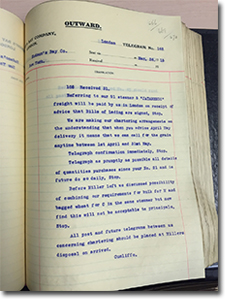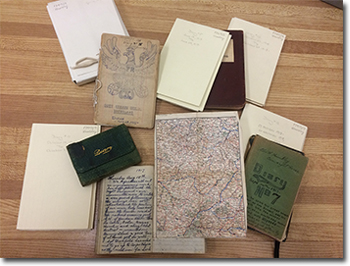The 100th anniversary of the First World War is now finished but the records will continue to be preserved at the Archives and accessible to current and future generations who want to know more about the time period. In addition, this blog will remain on our website as an additional resource.
April 2015 Posts:
- 27 April: Hudson's Bay Company & Cable Communications
- 22 April: Keeping a Diary in the Trenches
27 April 2015
Hudson's Bay Company & Cable Communications
During the First World War cables (also known as telegrams) were an almost immediate source of communication. They were relatively brief and senders were charged by the word and each word could be no longer than 10-15 characters, depending on whether they were written in code or plain language. The Hudson’s Bay Company (HBC) utilized this form of communication on a daily basis in the early 20th century, as demonstrated in a series of inward and outward cables records titled “Cables related to Hudson's Bay Company's wartime business with European governments” from 1914 to 1916.
Some of the cables were written using code and others were plain language. The cables were numbered and refer back to previous cables by those numbers (as seen in the two below). They dealt with orders for supplies, arrangements with suppliers, arrangements about shipping and other related business of the day.
Within this series we see that HBC executives sent and received cables daily, sometimes numerous times per day. For instance, in March 1915, 55 cables were sent and 62 cables were received. It is not surprising that the series takes up 1.5 metres of shelf space in the vault.
Search Tip: To find a description of these items in Keystone, use the series title as the keywords for the search, “Cables related to Hudson's Bay Company's wartime business with European governments.” The records are available for consultation upon request in the Archives Research Room.
Feedback (0)
E-mail us at [email protected] with a comment about this blog post. Your comments may be included on this page.
22 April 2015
Keeping a Diary in the Trenches
George Henry Hambley was one of over 600,000 Canadians who served in the First World War. Hambley enlisted at Camp Hughes (then Camp Sewell) on 13 October 1915 when he was almost 19 years old. He was a trooper in the Canadian Light Horse and served in France, Belgium, and Germany, fighting in the battles of Ypres, Mons, Cambrai, and Vimy Ridge.
While Hambley was one of many Manitobans who saw active overseas service in the First World War, he is significant because he kept diaries throughout the war. There are thirteen diaries in total from his enlistment in 1915 until the end of the war in November 1918 and others which document his time in Europe before he returned to Canada in 1919.
Hambley’s wartime diaries are not just accounts of the movement of troops, his own daily activities and stories of the people he met. They are also filled with sketches, poems, photographs, cards, letters and clippings.
After the war, George Hambley returned to Canada, attended Victoria College in Toronto and Wesley College in Winnipeg and then served as a United Church Minister in various Manitoba communities for over 40 years. During much of this time Hambley also kept a diary. He wrote his last entry the day before he died in February 1983.
Search the Keystone database and come in to the Archives Research Room to find out more about George Henry Hambley, to read his diaries and to learn more about Manitobans in the First World War.
Search Tip: Search “George Hambley” in Keystone for more information.
Feedback (0)
E-mail us at [email protected] with a comment about this blog post. Your comments may be included on this page.






